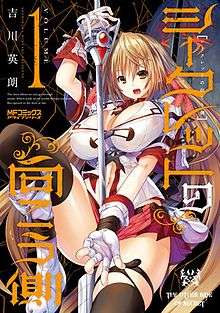The Other Side of Secret
| The Other Side of Secret | |
 The cover of the first volume. | |
| シークレットの向こう側 (Shīkuretto no Mukōgawa) | |
|---|---|
| Genre | Fantasy, Action[1] |
| Manga | |
| Written by | Hideaki Yoshikawa |
| Published by | Media Factory |
| English publisher | |
| Demographic | Seinen |
| Magazine | Monthly Comic Alive |
| Original run | 27 September 2014 – 27 October 2015 |
| Volumes | 4 |
The Other Side of Secret (Japanese: シークレットの向こう側 Hepburn: Shīkuretto no Mukōgawa) is a Japanese manga series written and illustrated by Hideaki Yoshikawa. The series is published by Media Factory in Japan and by Seven Seas Entertainment in the United States.
Release
Hideaki Yoshikawa began serializing the manga in the November issue of Media Factory's seinen manga magazine Monthly Comic Alive on 27 September 2014.[2] The series concluded in the magazine's December 2015 issue on 27 October 2015,[3] and has been collected into four volumes.
North American publisher Seven Seas Entertainment announced its license to the series on 14 July 2015.[4][5]
Volumes
| No. | Japanese release date | Japanese ISBN | English release date | English ISBN | |
|---|---|---|---|---|---|
| 1 | 22 November 2014[6] | ISBN 978-4-04-066897-0 | 9 June 2016[7] | ISBN 978-1-626923-1-64 | |
| |||||
| 2 | 23 March 2015[8] | ISBN 978-4-04-067287-8 | 13 September 2016[7] | ISBN 978-1-626923-30-0 | |
| |||||
| 3 | 23 July 2015[9] | ISBN 978-4-04-067571-8 | 6 December 2016[7] | ISBN 978-1-626923-70-6 | |
| |||||
| 4 | 21 November 2015[10] | ISBN 978-4-04-067841-2 | March 28, 2017[7] | ISBN 978-1-626924-41-3 | |
| |||||
Reception
Rebecca Silverman of Anime News Network gave the first volume a grade of B-. She felt that the story was interesting, but that the volume suffered from being mostly setup. She also felt that the series' fanservice was out of place, writing that it seemed "as if Yoshikawa felt the need to stop and give us a show before moving the plot along." She was positive toward the sibling relationships portrayed in the story, enjoying the fact that they were platonic as opposed to "distracting us with a forbidden love angle." She called the manga's art "serviceable without being particularly good", noting the lack of visible motion during action scenes, and commented that the series monsters were better drawn than its people.[11]
References
- ↑ "Seven Seas Enters a New World with The Other Side of Secret Manga License". Seven Seas Entertainment. 14 July 2015. Retrieved 14 May 2016.
- ↑ アライブで吉川英朗の新作&ライフアライヴ. Natalie (in Japanese). 27 September 2014. Retrieved 14 May 2016.
- ↑ 『学戦都市アスタリスク』の表紙が目印! 月刊コミックアライブ12月号好評発売中!. Media Factory Blog (in Japanese). 27 October 2015. Retrieved 16 May 2016.
- ↑ "Seven Seas Licenses The Other Side of Secret Manga". Anime News Network. 14 July 2015. Retrieved 14 May 2016.
- ↑ Green, Scott (14 July 2015). "Seven Seas Licenses "The Other Side of Secret"". Anime News Network. Retrieved 14 May 2016.
- ↑ シークレットの向こう側 1 [The Other Side of Secret 1]. Media Factory (in Japanese). Retrieved 14 May 2016.
- 1 2 3 4 "Other Side of Secret, The". Seven Seas Entertainment. Retrieved 14 May 2016.
- ↑ シークレットの向こう側 2 [The Other Side of Secret 2]. Media Factory (in Japanese). Retrieved 14 May 2016.
- ↑ シークレットの向こう側 3 [The Other Side of Secret 3]. Media Factory (in Japanese). Retrieved 14 May 2016.
- ↑ シークレットの向こう側 4 [The Other Side of Secret 4]. Media Factory (in Japanese). Retrieved 14 May 2016.
- ↑ Silverman, Rebecca (14 May 2016). "The Other Side of Secret GN 1". Anime News Network. Retrieved 14 May 2016.
External links
- The Other Side of Secret at Seven Seas Entertainment
- The Other Side of Secret (manga) at Anime News Network's encyclopedia